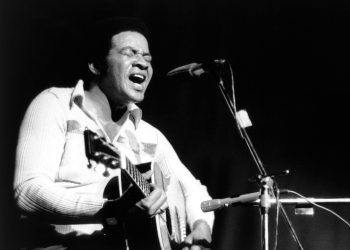Al Green is an iconic American singer, songwriter, and record producer known for his distinctive voice and influential contributions to soul and gospel music. Born in 1946 in Arkansas, Green achieved prominence in the 1970s with hits like “Let’s Stay Together,” “Tired of Being Alone,” and “Love and Happiness.” His music blends elements of soul, R&B, gospel, and pop, characterized by smooth vocals, heartfelt lyrics, and lush arrangements. Green’s emotive delivery and ability to convey deep emotions have earned him accolades and a lasting legacy as one of the greatest soul singers of all time.
1. Sha-La-La (Make Me Happy)

“Sha-La-La (Make Me Happy)” is a soulful and upbeat song by Al Green, released in 1974 as part of his album “Al Green Explores Your Mind.” The song features Green’s smooth and soulful vocals set against a lively groove and catchy melodies. “Sha-La-La (Make Me Happy)” is known for its joyful and infectious energy, with lyrics expressing a desire for happiness and love. The song’s upbeat tempo and uplifting vibe became a hit, showcasing Green’s ability to blend soul, R&B, and gospel influences into a timeless sound that continues to resonate with listeners.
2. L-O-V-E (Love)

“L-O-V-E (Love)” is a classic song performed by Al Green, originally released in 1975 as part of his album “Al Green Is Love.” The song is characterized by Green’s soulful vocals and smooth delivery, conveying a message of love and affection. “L-O-V-E (Love)” features a catchy melody and upbeat tempo, with lyrics that celebrate the joy and fulfillment found in romantic relationships. The song’s infectious groove and Green’s emotive performance contributed to its popularity, making it a favorite among fans of soul and R&B music. “L-O-V-E (Love)” showcases Green’s ability to capture the essence of love through his expressive voice and musical artistry.
3. You Ought to Be with Me

“You Ought to Be with Me” is a classic soul song by Al Green, released in 1972 on his album “Let’s Stay Together.” The song was written by Al Green, Al Jackson Jr., and Willie Mitchell, and it became one of Green’s biggest hits, reaching the top of the Billboard R&B chart and peaking at number three on the Billboard Hot 100 chart.
In “You Ought to Be with Me,” Al Green sings about wanting his lover to be with him and expressing his feelings of love and devotion. The song features Green’s signature smooth vocals, backed by a soulful arrangement of horns, guitar, and drums.
“You Ought to Be with Me” is a classic example of Al Green’s soulful sound and his ability to blend elements of gospel, R&B, and pop music. The song’s catchy melody and heartfelt lyrics have made it a favorite among fans of classic soul music and have helped solidify Al Green’s reputation as one of the greatest soul singers of all time.
4. Let’s Stay Together

“Let’s Stay Together” is a classic soul song by Al Green, released in 1971 on his album of the same name. The song was written by Al Green, Willie Mitchell, and Al Jackson Jr., and it became one of Green’s signature songs, reaching the top of the Billboard Hot 100 chart and the Billboard R&B chart.
“Let’s Stay Together” is a romantic ballad in which Al Green sings about wanting to stay together with his lover. The song features Green’s smooth, soulful vocals, backed by a lush arrangement of strings, horns, and rhythm section.
“Let’s Stay Together” is renowned for its timeless appeal and has been covered by numerous artists over the years. It is considered one of the greatest soul songs of all time and has helped solidify Al Green’s reputation as one of the greatest soul singers in music history.
5. Tired of Being Alone

“Tired of Being Alone” is a soulful ballad by Al Green, released in 1971 as part of his album “Al Green Gets Next to You.” The song is characterized by its smooth groove, heartfelt lyrics, and Green’s emotive vocals. “Tired of Being Alone” explores themes of loneliness and longing for companionship, with Green expressing a deep desire for love and connection. The song’s soulful melody and poignant lyrics resonated with audiences, becoming one of Green’s signature songs and a classic in the soul genre. Its enduring popularity reflects Green’s ability to evoke powerful emotions through his music and vocal delivery.
6. Call Me (Come Back Home)

“Call Me (Come Back Home)” is a soul song by Al Green, released in 1973 on his album “Call Me.” The song was written by Al Green, Al Jackson Jr., and Willie Mitchell, and it became one of Green’s biggest hits, reaching the top of the Billboard R&B chart and the top ten of the Billboard Hot 100 chart.
In “Call Me (Come Back Home),” Al Green sings about longing for his lover to come back to him, promising to be there for them no matter what. The song features Green’s signature smooth vocals, backed by a soulful arrangement of horns, strings, and rhythm section.
“Call Me (Come Back Home)” is considered one of Al Green’s classic songs and has been covered by various artists over the years. It is known for its heartfelt lyrics, catchy melody, and soulful groove, making it a favorite among fans of classic soul music.
7. Love and Happiness

“Love and Happiness” is a soulful anthem by Al Green, released in 1972 as part of his album “I’m Still in Love with You.” The song is characterized by its infectious groove, captivating rhythm, and Green’s passionate vocals. “Love and Happiness” explores the themes of love, fulfillment, and emotional well-being, with Green expressing the joy and contentment that come with love. The song’s irresistible melody and uplifting lyrics made it a hit, becoming one of Green’s most iconic tracks and a cornerstone of his musical legacy. Its enduring popularity has cemented “Love and Happiness” as a timeless classic in the soul and R&B genres.
8. Take Me to the River

“Take Me to the River” is a song written by singer Al Green and guitarist Mabon “Teenie” Hodges. It was first recorded by Al Green in 1974 for his album “Al Green Explores Your Mind.” The song has since been covered by several artists, including Talking Heads.
Al Green’s original version of “Take Me to the River” is a soulful track with a smooth groove and heartfelt vocals. The lyrics express a longing for spiritual cleansing and renewal, using the metaphor of a river as a symbol of transformation and rebirth.
Talking Heads’ cover of “Take Me to the River” was released in 1978 on their album “More Songs About Buildings and Food.” The band’s version of the song has a more upbeat, new wave sound, with David Byrne’s distinctive vocals adding a quirky edge to the track.
Both versions of “Take Me to the River” have been praised for their unique interpretations and have become classics in their own right. The song’s enduring popularity and universal themes of redemption and renewal continue to resonate with audiences today.
9. I’m Still in Love with You

“I’m Still in Love with You” is a soulful ballad by Al Green, released in 1972 as the title track of his album. The song showcases Green’s smooth and emotive vocals, accompanied by lush instrumentation and a melodic arrangement. “I’m Still in Love with You” explores themes of enduring love and devotion, with Green expressing his heartfelt emotions and commitment to a romantic relationship. The song’s soulful melody and romantic lyrics resonated deeply with listeners, becoming one of Green’s signature songs and a classic in the soul genre. Its enduring popularity reflects Green’s ability to convey genuine emotion and capture the essence of love through his music.
10. Here I Am (Come and Take Me)

“Here I Am (Come and Take Me)” is a soulful track by Al Green, released in 1973 as part of his album “Call Me.” The song features Green’s smooth and soulful vocals set against a backdrop of lush instrumentation and a catchy groove. “Here I Am (Come and Take Me)” explores themes of love and vulnerability, with Green expressing his willingness to surrender to love and embrace emotional intimacy. The song’s melodic chorus and heartfelt lyrics resonate with listeners, capturing the joy and passion of romantic devotion. It became a hit for Green, showcasing his ability to blend soul, R&B, and gospel influences into a compelling musical expression of love and longing.









